Weight vs. Volume is a recurring question that many soapers, lotion makers and general crafters have grappled with in the pursuit to make the perfect product. In all my years of soaping, the weight versus volume question has been the one that I (and our customer service team) have gotten the most. Ounces, as a unit of measurement, are used to quantify both weight and volume. The difference is slight but very important!
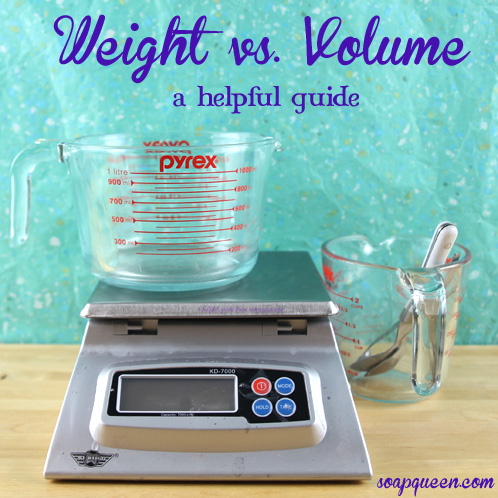
Keep in mind that unless otherwise noted in Soap Queen tutorials (and almost all soap and toiletry recipe books), ingredients are measured by weight and not volume. For example, you’ll rarely see a tutorial call for a “cup of oil,” because oils have different densities. Some oils are heavier than others, and so to get the most accurate measurement possible, weight measurements are used. That’s why you’re much more likely to see a recipe call for “2 oz. of oil”. Below is a general guide to the difference between weight and volume, and what it means when you are purchasing and working with Bramble Berry’s products.
Weight: Weight is determined by the heaviness, or mass, of the particular item, and is measured with the use of a scale. We sell most products at Bramble Berry by weight so that you are getting the same amount every single time that you order. It’s also helpful in determining the amount of product to buy for your favorite recipes. Products sold by weight at Bramble Berry include popular items like butters, fixed oils and fragrance or essential oils.
Volume: Volume is the amount of space that an item you are measuring takes up. It’s a common measurement in food recipes and recipes where ratios are more important than precision. For example, if you’d like to make a baby oil recipe that does not require a chemical reaction (like emulsion or saponification) and the goal is to utilize the space of your packaging/containers while maintaining a specific ratio of ingredients, volume measurements are the way to go. When you’re looking for packaging, note that containers, jars, bottles, etc. are labeled by their volume measurements, or the amount of space that a product will take up within them. An 8 oz Bail Jar will hold 8 oz of product by volume, not necessarily by weight, so keep that in mind if you’re working with a hand cream recipe whose yield is measured by weight.
Here are some visuals to help you out. Let’s say you’ve ordered 6 different Bramble Berry Fragrance Oils, all in a 4 oz size. Your order might look something like this:

And you’re thinking, huh, did some of my bottles leak? Why is the Ginger Ale filled to the brim but Vanilla Select is only about 3/4?
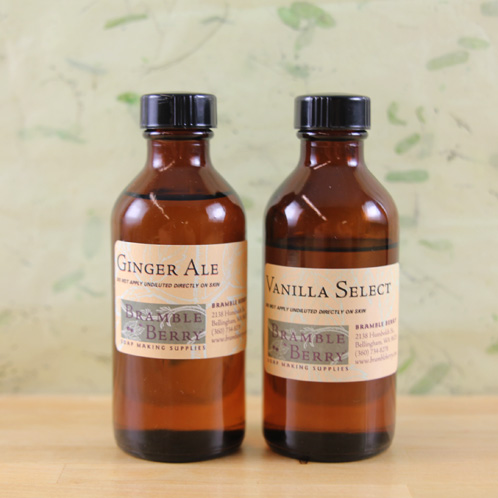
The (literally hundreds of) components that make up individual fragrance oils can vary based on what the final scent goal is. Typically you’ll discover that sugary-sweet fragrance oils are more dense, heavy and viscous, while a citrus-based fragrance oil might be relatively light and thin in density. Hence, when your Bramble Berry fragrance order is hand-poured and weighed to order, you are getting accurate weight measurements while visually, it appears that your fragrance oils aren’t quite matching up.
Check out the difference between Green Chrome Oxide (on the left) and Titanium Dioxide (on the right). Both are weighed out to one ounce, but clearly the Green Oxide is the more dense and heavy of the two colorants. Think about the old joke “Which weighs more, a pound of feathers or a pound of bricks?” The joke being that they weigh the same, but will visually appear to have very different measurements.
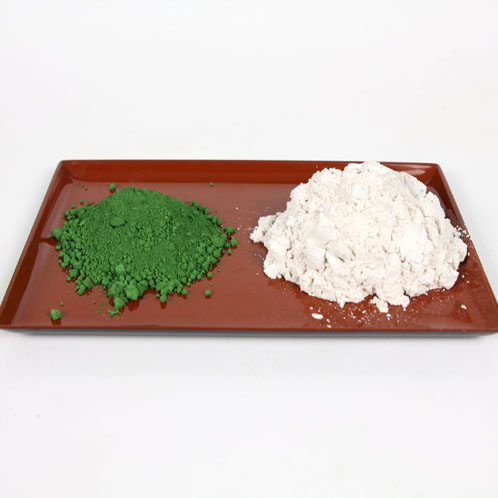
Even the same exact product can vary in its volume vs. weight measurements! Below are some common fragrance and fixed oils measured by both volume and weight. The glasses on the left show 4 oz. of oil by volume while the glasses on the right show 4 oz. of oil by weight. You’ll notice that throughout the photos, the level of liquid on the left stays consistent while the level of liquid on the right fluctuates. A volume measurement will remain visually static regardless of the weight or viscosity of the article being measured. A weight measurement will vary to the eye, but not to the scale.
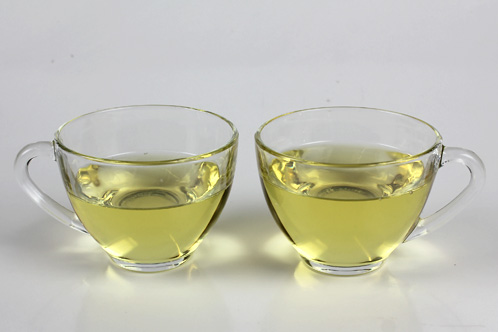
Wasabi Fragrance Oil by Volume/Wasabi Fragrance Oil by Weight
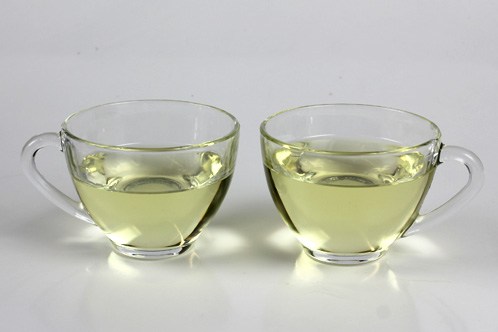
Pink Grapefruit Fragrance Oil by Volume/Pink Grapefruit Fragrance Oil by Weight
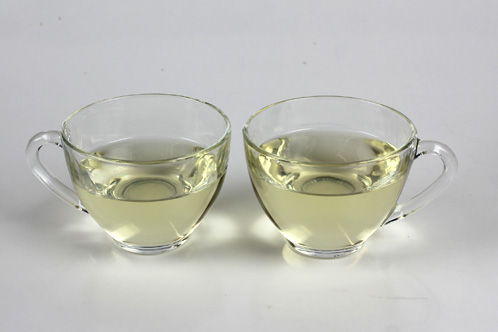
Sunflower Oil by Volume/Sunflower Oil by Weight
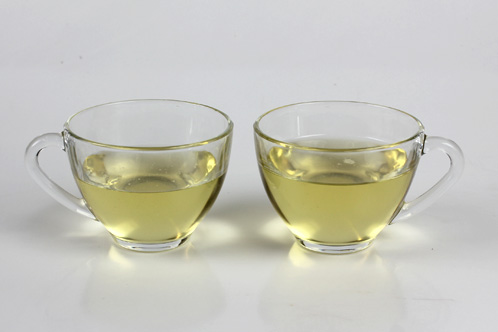
Castor Oil by Volume/Castor Oil by Weight
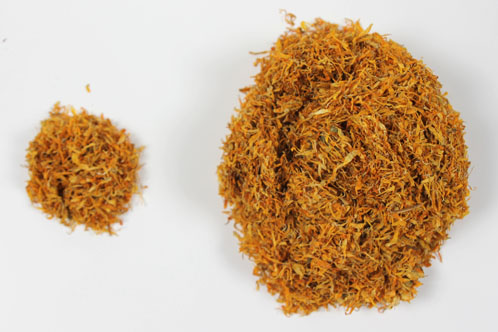
And finally, here’s an herb that really illustrates what we mean! On the left is Calendula measured by 3 ounces of volume, and on the right there is 3 ounces by weight. Because this herb is so light and fluffy, it takes significantly more to achieve 3 ounces of it by weight. For more examples of weight vs. volume, check out this previous blog post.
Have any more questions about Weight vs. Volume? Let us know in the comments below!

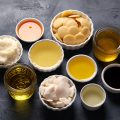
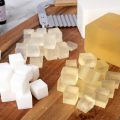
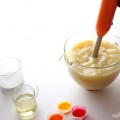
![1420big20frosting[1]](https://www.soapqueen.com/wp-content/uploads/2014/03/1420big20frosting1-120x120.jpg)
I always find this topic amusing – coming from the UK – as we use grams and kilograms for food and similar measurements, so we use a ‘true weight’. My parents are of the ‘pounds and ounces’ generation and counting things in 12s is just weird now in the uk! Gotta love decimilisation! All in 10’s! Much easier! Measuring in cups here is strange as we don’t have a ‘standard’ cup size so it feels like an arbitrary unit of measurement to us. Also, you get less of everything in the US system, our ‘pints’ of beer / lager in a pub are so much bigger in the uk, everything here is sold by weight and it’s easy to work out f you need to use a 1/4 of a packet for something and you don’t have to worry about viscosity and cutting things up tiny to get them to fit in a ‘cup’ – wanna join us all metric? It’s awesome! 🙂
Hi Em!
It’s interesting to hear about all the measurement differences between the U.S. and the U.K.! Thanks for sharing. 🙂
-Kelsey with Bramble Berry
Please dumb this topic (volume vs. weight) down for me:
Ok so here is what I know
My mold cavities hold 1/3 cup, when 1/3 cup is filled with water it weighs 2.45 oz
My mold has 18 cavities
Here is what I need help with
Since 1/3 cup= volume and oil weighs less than water…….
How do I figure out how much soap batter to make so that I do not have a shortage or an overage?
Thanks a bunch!
I came here for this question, too. I have the spherical molds, I know they hold 3.5 oz per mold (total of 14 oz for all four in volume) but how much soap do I need in a weight measurement would I need? The problem with this is that we are both missing one piece of information for the equation – the density of the soap. If I use one kind of soap, it may weigh more than another, which means I will need more or less of it to equal the 14 oz of volume than another. I cannot locate any information on the density of the melt and pour soaps from Brambleberry, so I am going to have to just guess and then record my findings for future use.
Hi Jenna!
Our molds are actually weight measurements. For the spherical molds, they hold 3.5 ounces by weight. The density of the soap will definitely play a factor, so it can help to make a little extra soap to see if you have any extra leftover. However, the weight measurements tend to be fairly accurate. 🙂
4 Sphere Silicone Mold: https://www.brambleberry.com/4-Sphere-Silicone-Mold-P5272.aspx
For the Rainbow Spheres tutorial, we used about 15 ounces of soap per mold, and had a little bit extra left over: http://www.soapqueen.com/bath-and-body-tutorials/melt-and-pour-soap/rainbow-spheres-2/
-Kelsey with Bramble Berry
So technically we are getting ripped of by purchasing liquids by weight! It is very dissapointing.
Hi Kp!
We actually measure most of our products by weight so you get an accurate amount each time. This ensures you are getting your money’s worth!
For instance, if we gave you 3 oz by volume of Marigold, it would be a lot less than 3 oz by weight as shown in the picture above!
This also goes for our Ginger Ale Fragrance Oil. If we measured by volume, you would get less product because it’s such a light oil.
Let me know if you have any more questions!
-Kelsey with Bramble Berry
Marigold: https://www.brambleberry.com/Marigold-calendula-Dried-P4017.aspx
Ginger Ale Fragrance Oil: https://www.brambleberry.com/Ginger-Ale-P4161.aspx
I am a newbie and about to try your “Lots of Lather” recipe which is in ounces. Should recipes given in ounces be used as is or converted to grams? Thanks!
Hi Kathy!
You could use either grams or ounces, whatever you feel more comfortable with. But if a recipe is in ounces, you do not need to convert it, unless you want to do so! 🙂
-Amanda with Bramble Berry
I’ve read in a recommended soapmaking book that your water/liquid is always measured by volume, and oils by weight. My soap usually turns okay. But have seen soapers on youtube measuring their water by weight as well. It’s confusing. But, if I’ve been doing it wrong this whole time, it might explain a few things.
Hi Katy,
All recipes on SoapQueen.com are measured by weight — that includes the water! We do this because it is a much more accurate way to soap. As you can see from this post, measuring by weight avoids confusion and eliminates inconsistencies. I’m glad measuring water by volume has worked for you, but I would highly recommend adding your water by weight for the best results 🙂
~Kevin with Bramble Berry
Hi Katy,
When you’re talking about WATER only, the weight and the volume is the same. If you take a cup of water (8 oz) and put it on a scale, it will read 8 oz. This is considered “fluid ounces” and water is the base for all fluid ounces. But if you think about oil, it floats on top of water. That is because oil is less dense than water. It will weigh less if you put a cup of oil next to a cup of water on a scale.
I can see why a soaping book would say water can be measured in volume. For water only weight equals volume.
One more question! So concerning the ounce vs. fluid ounce thing – am I right in saying that anytime I see “fluid oz.” anywhere, it means volume, and anytime I see just plain “oz.”, it means weight, even though it doesn’t actually say weight?
Sorry for so many questions… I am right there with Patricia when she says “inquiring minds want to know”. I like to know every detail. EVERY detail.
Thanks!
Hi Liv!
Don’t be sorry at all, these are good questions! You’re correct, it’s a safe assumption that oz. refers to weight, and fluid. oz refers to volume. I hope these answers helped!
-Amanda with Bramble Berry
I asked a question about weight vs. volume and was referred to this post for more information. This is very informative and good for visualizing the difference in weight vs. volume, so thank you for that! But I still am not clear on my question.
What I am unsure of is why measuring ingredients by weight is more accurate than by volume. The example I asked about in my original question was what if I’m going to make two batches of soap, one with very light oils, the other with very dense, heavy oils. Let’s say both recipes called for 16 oz. (by weight) of oil. Therefore, both measured out oils would weigh the same when placed on the scale, but the lighter oil would take up a lot more room in the measuring cup. It would take up a lot more volume. Now I come to my question. Even though both soap batches weigh the same, won’t the one made with lighter oils actually produce more soap, since the oils take up more space? Even if you cut each finished, saponified block of soap into four, 4 oz. bars, won’t the bars made with the lighter oil actually be larger in size than the ones made with the denser oil? I understand that all the bars would weigh exactly the same, but I don’t understand why they would all be the same size.
Or what if you were making two CP soap batches with two different fragrances, one dense and the other light. Let’s say you used the 2 fragrances in the example in this post, Ginger Ale and Vanilla Select. If you use 2 oz. by weight of the dense fragrance (Vanilla Select) for one recipe, and 2 oz. by weight of the light fragrance (Ginger Ale) for the other recipe, you would end up adding more Ginger Ale visually, as can be seen in the example, than Vanilla Select. So would the soap made with Ginger Ale fragrance not smell stronger? Why?
I must be missing some deeper level of chemistry behind all this. I hope you can straighten me out!!
Thank you, all your blog posts are always very enlightening!
Liv
Hi Liv!
You’re correct, the soap made with denser, heavier oils would be slightly smaller than a bar of soap made with light oils, but still weight the same. In general it won’t be a huge difference though.
As far as your question regarding fragrance oil, you will end up adding more fragrance oil visually with a lighter fragrance such as Ginger Ale, than you would with a heaver fragrance such as Vanilla select. But because the lighter fragrance oil weighs less, you will reach about the same amount of fragrance strength as a heavier oil. Always using weight vs. volume is a great way to become consistent in your soapmaking. Also, keep in mind fragrances are extremely personal anyway, and that while there is a recommended usage rate for fragrances, people use them differently depending on what they like.
I hope this helps Liv, wieght vs. volume is certainly a topic that can make your head hurt a little, haha 🙂
-Amanda with Bramble Berry
Thank you Amanda! This helps a lot, clears up several things for me! So, if I understand correctly, even though there will be more Ginger Ale fragrance than Vanilla Select, the Vanilla Select is heavier and stronger, so the scent strengths will actually end up being equal? Also, about the soap made with the heavy vs. light oils: even though the one made with light oils will be a little larger, will the one made with heavy oils be a little longer lasting, so everything ends up evening out?
All this is making more sense now, thank you so much!!
Liv
Hi Liv!
Yes, these are good ways to think about it. As to if the “heavier” bar of soap will actually last longer, I’m not sure it would! If they do, I’m sure it would be a small difference. I hope this helps 🙂
-Amanda
Thanks Amanda!! You guys are the best!
hello i am very new at making soap and right now i am trying to make 2 ounces of soap to start out with total of grams is total is 56.699 i have palm oil and other type of oils to work with it the water and lye measurement i have problems with….i try using soap calculator and i really do not understand what i doing…..i have read on books but they call for bigger batches and well i like to start out with 2 ounces batches….any help would be great full for sure…..thank you again and happy holidays to all
Hi Tammy!
When using the lye calculator, first decide if you’re making liquid or bar soap (sounds like you’re making a bar). Then you need to add the individual amounts of oils in either grams, ounces or percentages and enter the amount of each next to the box for each oil. You then can choose a superfat level (we recommend 5%) which is the amount of oils that have not been saponified by the lye. This will give the amount of water and lye needed, as well as your yield.
Here are some links to get you started! I hope this helps, if you have more questions let me know!
Beginners Guide to Cold Process:http://www.soapqueen.com/bath-and-body-tutorials/cold-process-soap/free-beginners-guide-to-soapmaking-cold-process/
Superfatting- An Explanation: http://www.soapqueen.com/bath-and-body-tutorials/cold-process-soap/superfatting-soap-an-explanation-2/
Formulating Cold Process Recipes: http://www.soapqueen.com/bath-and-body-tutorials/tips-and-tricks/formulating-cold-process-recipes/
Beginners Guide to Common Soapmaking Oils: http://www.soapqueen.com/bath-and-body-tutorials/tips-and-tricks/free-beginners-guide-to-soapmaking-common-soapmaking-oils/
-Amanda with Bramble Berry
I recently made the goat milk in the pot swirl soap after watching the tutorial. She specifically says to measure the milk by volume and that volume uses a decimal point that goes out two places. So my scale will measure in fluid ounces (which is volume) and I used that. The soap came out fine.
I made the soap again yesterday using the milk by weight instead and the soap came out much wetter. Can I assume it was the difference in milk weights?
Should I be using ounces or fluid ounces to measure the frozen goat milk?
Thank you so much for these conversations. I learn so much from them!
Maralee
Good morning, Maralee!
In certain recipes, you will need to use volume instead of weight because of the density of certain ingredients. Goats Milk is actually one of those, and we’ve found that if you go by fluid ounces it works a lot better than weight because of how much heavier it is than water.
When making your batches with goats milk, we suggest measuring your batch out by fluid ounces (volume). I hope that this helps! =)
-Becky with Bramble Berry
Hi,
I’m writing from Greece and is very difficult for us here to make your recipes because we use gr instead of oz. Can you help me to find a way to make it right?
Thank you very much, you are such an inspiration for us
Zoe
Good morning, Zoe!
The easiest way we’ve found to translate ounces to grams is to use Google’s Conversion Calculator. Just type in the search bar ‘Ounces to Grams’ and it will pop-up a handy calculator that can convert any of our recipes! And, if you have a question on a specific recipe, be sure to let us know so we can help you out. =)
Happy Soaping!
-Becky with Bramble Berry
Very useful. Thanks guys
Hi Odette!
We are so glad to hear that you’ve found this to be as helpful as we did. Volume versus weight can be tricky when you are first starting out and we definitely wanted to help out customers understand the difference. If you have any questions, don’t hesitate to ask! 🙂
-Becky with Bramble Berry
This post is awesome! Thanks so much for sharing it and taking the time to put it all together 😀
Glad that you like it! Thanks for the kudos =)
-Kristen with Bramble Berry
Thanks for explaining how weight and volume differ as pertains to the soap making process. The pictures are great visuals!
Happy to hear that this was helpful! Thanks for stopping by 🙂
Kristen with Bramble Berry
Ok. I get that, but that brings up a question. (Actually a string of several, but who’s counting?)
How is it that when measuring a soap mold, you are measuring VOLUME (the actual space) to determine the WEIGHT of the oils necessary to fill that volume? (I know the equation… L x W x H x .4 = ozs. of oil.)
Am I to understand that with the only variable being the height of the soap, you can have a shorter soap, a taller soap, or even too much to put into the mold, depending on the weight of the oils used. Is that correct? I always seem to have more, so does that mean I’m using more of the lighter, less dense oils?
And that brings up another question (since I’m a math giant.) Does that .4 number represent the water as a percentage of the oils? .4 = 40%. SoapCalc suggests 38% – very close to 40%.
Ok…that brings up yet another question! I ran one of the soap recipes in A-M’s new book, and it appears she is soaping at 33% water as a percentage of oils, if I understand this and did the math right, (and with a 5% superfat.) Then I ran two more and I think those 2 numbers were the same. Do you use less water because of your humid environment? I live in a very dry climate, but I’m interested in the humidity factor. I understand some soapers use a dehumidifier to counter this issue. Is there a particular humidity percentage at which time one should lower the amount of water one soap’s with? And if you lower the water, does that accelerate trace?
I was also a bit surprised at the numbers when looking at the fatty acids, iodine & INS totals, which seem to be out of acceptable range, at least according to SoapCalc. I understand that some recipes are more conditioning, some more cleansing, etc., but out of range? The BB calculator doesn’t display the resulting composition. Aren’t those ranges important to know in order to have a balanced bar?
Somewhat exasperating is that every soap calculator I’ve used figures differently…arg. I figure they must have differing SAP values. I know such values can vary upon a few different factors, but it sure makes it difficult to trust any calculator. Who’s to say SoapCalc is correct or any other for that matter? Better to figure it manually I guess, based on manufacturer’s SAP number of the particular lot at time of purchase.
Ok….that’s ONLY 11 questions, but the first one doesn’t count. You’re not counting, right? (Ok…that was #12!) 🙂
Sorry…in advance. Slightly befuddled. Inquiring minds want to know.
Hi Patricia! You’ve got a ton of great questions here so I’m just going to go straight down the line with my answers =)
When you’re measuring the volume of a soap mold to get the weight of oils to use, the formula L x W x H x .4 is helping you get to a point where you have a general idea of where to start. Basically, it’s facilitating an educated guess instead of a blind leap. It’s not going to perfectly fill the mold since you are using a volume measurement to guesstimate your weights, it’s just offering a jumping-off point. Most oils’ weights are close enough to their volume measurements that in this case, you can switch from volume to weight because you are not working with a specific unit that needs to match another unit as precisely as possible in order to create a chemical reaction.
Which brings me to the next question; if you were to go by the measurement L X W X H alone, you would get the full volume of your container. Most often when soaping, however, you don’t actually want to fill the mold to the brim so the .4 is there to cut that measurement so that your volume is at an appropriate height to fit your soap into the mold. Theoretically you could get the same result by altering the height measurement and leaving off the .4 at the end.
Anne-Marie doesn’t soap based on humidity (while it’s definitely not dry here in Washington State, it’s not the most humid either), but you certainly can lower your water amount in your recipe (called water discounting) if you think that humidity is a concern OR if you’d like your bars to harden up quicker. It’s my experience that dehumidifiers are another method of hardening up bars too. And yes, the less water you use (ie: the higher the water discount you take), the more prone your soap will be to accelerating trace.
The water percentages used in soap recipes are a value range, and can vary based on which lye calculator you use or by soaper’s preference. Typically this value can be from 28 – 35% or more. The reason for the range is that water is basically a vessel for your lye, and different soapers or soap calculator developers have most likely found a percentage that seems to work best for them. Less water leads to a quicker-to-harden bar but higher chance of accelerated trace, while more water leads to a slower-to-harden (ie: longer cure time) bar but more potential for water amount not being the cause of accelerated trace.
INS numbers aren’t something that Anne-Marie typically consults when formulating her recipes. She prefers to rely on her own experiences and tests and the results that she gets when the bar is put to use instead of where the INS numbers put her bar (you can read more about her thoughts on INS numbers here: http://www.soapqueen.com/bath-and-body-tutorials/cold-process-soap/ins-numbers-for-soapmaking/). There’s nothing wrong with INS numbers, it’s just her preference.
Regarding varying lye amounts; most every ingredient that has a SAP value actually has a SAP value range. Soap Calculator developers can take into consideration any value in this range when they are making their calculators. Bramble Berry’s soap calc errs on the conservative side of that range because as much as we are all perfect soap makers, we are all also human. =) If you’re concerned about your soap calc’s results, keep in mind that your superfat percentage will also play a role in absorbing any potential lye overages and that you can bump that percentage up if you feel the need.
Whew, I hope I got everything! Let me know if you have any other questions =)
Kristen with Bramble Berry
Thanks, Kristen!
I feel a bit better knowing I don’t have to worry as much about the INS numbers if A-M gets good results.
The only thing I don’t quite understand about your answer is the .4 amount. If you multiply the L x W x H by .4, aren’t you removing 40% of that volume to allow space for a recipe that includes up to 40% of water?
Also, I happened to think of something else. Does Sodium Lactate, used to increase hardness, accelerate trace? Or is that simply used to add hardness to say, a highly conditioning bar without accelerating trace?
Patricia, you are correct about the 0.4 in the formula for guesstimating your oil weight for a mold. You might prefer this calculation instead: http://www.soapguild.org/blog/2012/09/soap-mold-volume/
Every formula will be different dependent on your soapmaking oils, additives, water percentage/lye solution strength, fragrance used, etc. Some of my formulas need 50 ounces to fill the 10″ BB Silicone mold, others need 52 ounces.
If you wanted to calculate for a higher or lower fill, you would change your height # in your calculations.
Thanks Kenna for jumping in on the weight/volume thing.
Sodium Lactate doesn’t accelerate trace in my experience. I love it whenever I work with silicone molds.
Thank, Kenna! By the way, I’ve been reading your blog & got your e-book on master-batching, though I’m not anywhere near there yet. You are a gifted writer! Thanks for the link – I will check it out.
I must have hit the wrong reply button to Kenna. 🙂
But thanks, A-M, since I didn’t know Sodium Lactate is especially helpful with silicone molds since that’s primarily what I use. I bought some from you a while ago but have yet to use it. I’m looking forward to trying out the recipes in your AWESOME new book!
Of course, A-M. 🙂
Thank you for the kind comments, Patricia! Here’s to soaping success so you can grow into masterbatching sooner rather than later! 😉
Awesome thank you so much for the explanation
We’re stoked that you liked it!
Kristen with Bramble Berry
Hi
Am I correct to use the following measurement in soap making?
Oil – weight
Fragrance / eo – volume
Water, milk or juice – weight
Herbs and powder – weight
Color – volume
How about skincare such as lotion and cream?
Really need your help.
Tq
Nik
Great question!
Actually, I would recommend measuring by weight for cold process and lotion recipes. And I would do that for all of the ingredients when possible (see my comment above about ml). While water volume and weight are the same, it’s just a really good habit to have to weigh everything you are using.
And the other benefit of weighing your ingredients is that when you go to repeat a recipe – you will have more consistent results.
Ok so then everything should be weighed to get the correct amount and not measured which would give volume. But what about when one of your recipes says to use 2ml or 16ml – I’m using the BB droppers – isn’t that volume? So then if I were to choose a different fragrance oil than what is given in your recipe, aren’t I taking a chance since the density could be different?
Thanks!
Elaine
Hi Elaine,
You are correct! ml are a measurement of volume. We only use ml when the amounts are very small – since 2 ml would be about .067 ounce – most people don’t own a scale that measures out 3 decimal points. So we use ml to make our recipes be accessible for more people to re-create.
You will notice that in our Cold Process recipes that we pretty much always list the fragrance by weight. Because CP recipes need a little more precision – than say a potpourri recipe – to make sure they work correctly.
Bless your heart for taking the time to illustrate and explain this! I am literally about to make my very first batch of soap ever so this is right on time! You just made a lot of things click for me. (Btw…I just received your book in the mail yesterday, and I’m more than excited to get started :-))
Wahoo! Congrats on your first batch of soap. Share a picture with us on our Facebook page once it’s made! I’m excited to see what you wind up trying from the book, too 😉
Kristen with Bramble Berry
Bramble Berry on Facebook: http://www.facebook.com/BrambleBerry
your the bomb babe’s
thank you all
M
Haha right on! Glad you liked the guide 🙂
Kristen with Bramble Berry
Great Explanation!!
Thank you!
Glad you found it helpful, Sly!
Kristen with Bramble Berry
It’s like having air popped popcorn that weighs nothing but takes up a lot of space. Or Good & Plenty candies that take up less space but weigh more 🙂
What an awesome (and tasty) analogy!
Kristen with Bramble Berry
Technically speaking, weight is actually the force of an object due to gravity (so 1 oz of fragrance would have a different weight on Earth than on the moon, for example). In addition, weight is a measured quantity, not a measurement system. A measurement system would be the SI or CGS system.
Great point! We love suggestions from fellow soapers that help to make our guides as comprehensive as possible =)
-Kristen with Bramble Berry
The other issue when talking about ounces is that there are fluid ounces – which is actually a measurement of volume. Talk about confusing!